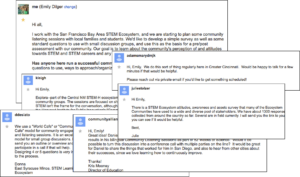There are currently 37 STEM Learning Ecosystems across the country. The Ecosystems are cross-sector networks that operate in different environments with different objectives, but all agree on the importance of understanding community needs. Responding to requests from the varying Ecosystems, we recently hosted a webinar focused on community listening and engagement. Here are a few highlights.
Dr. Emily Dilger, Bay Area STEM Ecosystem Coordinator, shared about the group’s Community Listening Sessions. They hadn’t undertaken this type of research before, so at the outset, she solicited input from the STEM Learning Ecosystem network and received severable valuable planning suggestions.
She then worked closely with members of the Bay Area Ecosystem to carry out the listening sessions. Dilger’s suggestions for gathering feedback from your community include:
- Find out what similar networks or organizations have done and learn from their experience.
- Implement methods for gathering information with different depths of conversation: in-person surveys, small group conversations, individual interviews.
- Leverage volunteers to fan out across the community to ensure input from a variety of audiences.
- Try to enlist partner organizations to support your efforts (i.e., provide free museum tickets to people who participate).
 On the webinar, Dr. Donna DeSiato, Superintendent of the East Syracuse Minoa Central School District and STEM Learning Ecosystem lead, emphasized the importance of taking ample time to plan community engagement efforts. She also pointed out the need to include the depth and breadth of all community groups that are affected by or involved in the STEM programs. For instance, there may be people in the community who don’t have children in school but they will be impacted by a STEM agenda and should be involved in the conversation.
On the webinar, Dr. Donna DeSiato, Superintendent of the East Syracuse Minoa Central School District and STEM Learning Ecosystem lead, emphasized the importance of taking ample time to plan community engagement efforts. She also pointed out the need to include the depth and breadth of all community groups that are affected by or involved in the STEM programs. For instance, there may be people in the community who don’t have children in school but they will be impacted by a STEM agenda and should be involved in the conversation.
The Central New Mexico STEM-H Hub set out to “listen, welcome, and co-create” in order to effect real change in the community. Kristin Leigh is Deputy Director and Director of Engagement at Explora!, the backbone member of the Hub. Leigh said they joined the conversations of a wide range of community groups and associations to ensure they would reach diverse populations. The listening sessions spanned a huge range of interests from bicycling clubs to neighborhood associations, from immigrant groups to those working with special needs audiences.
 Daniel Aguirre, Community Engagement Manager at the Fleet Science Center in the San Diego STEM Ecosystem, highlighted the importance of explaining their work as they talked with families through a neighborhood-focused approach in bilingual Community Listening Sessions. Many people did not understand why they were conducting a survey and wanting to meet with the families – or what they did with the information they collected. Once that was explained, they were more willing to participate.
Daniel Aguirre, Community Engagement Manager at the Fleet Science Center in the San Diego STEM Ecosystem, highlighted the importance of explaining their work as they talked with families through a neighborhood-focused approach in bilingual Community Listening Sessions. Many people did not understand why they were conducting a survey and wanting to meet with the families – or what they did with the information they collected. Once that was explained, they were more willing to participate.
Whether gathered through surveys, informal conversations, or formal meetings, once data is collected and analyzed, it should reveal trends to help you establish valuable plans. For example, the New Mexico STEM-H Hub’s research encompassed hundreds of people in more than 20 disparate groups, yet seven aspirations were common across the entire population. Those became the foundation of future projects.
Listening to your community is critical to success. As these Ecosystems demonstrate, you should seek the guidance of partners if you’re new to the process; follow a plan with thoughtful preparation and careful execution; then apply the information to create programs and processes that are truly centered around your community.
Members of the STEM Learning Ecosystems Community of Practice can view the webinar, held February 7. And mark your calendars; a helpful webinar is offered the first Tuesday of every month.

